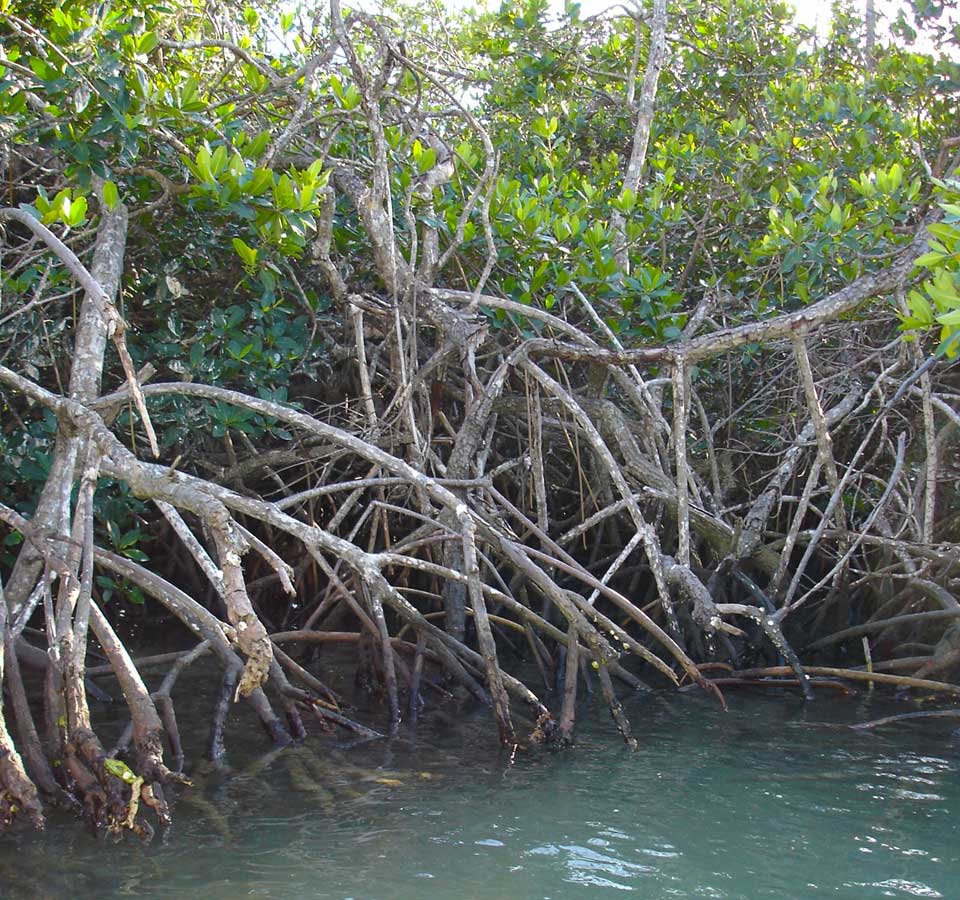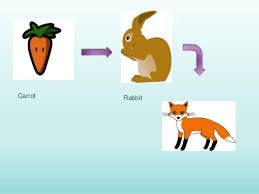True or False-All food chains can be traced back to energy from the sun.
This is true. All consumers have to either eat producers or, at some point on the food chain, rely on a consumer that has eaten producers.
This is a body part or behavior that helps an organism to survive in its environment.
What is an adaptation?
How would the flippers on a dolphin help it in the aquatic environment?
The flippers help it move more easily in the water.
The following adaptations all help organisms survive in this particular type of habitat.
*a cactus stem can hold water *a fennec fox has large ears to help cool its body *a camel's hump stores fat and water *the gila monster lizard makes its home underground *many other organisms are active at night rather than during the day (nocturnal)
Which environment?
These adaptations help the organisms survive in hot, dry desert conditions.
Florida alligators often swim with only their eyes and snouts exposed. Why would this behavior be helpful for obtaining food?
The alligator can sneak up on its prey and increase the chances of catching it.
This term refers to organisms that make their own food (like plants).
What are producers?
What is false? Once an organism is extinct, they can not be brought back.
Why would a snowshoe rabbit have brown fur during the spring and summer and white fur during the fall and winter?
It is an adaptation that helps the rabbit blend in with the surroundings. White fur will better blend with snow, while brown fur will better blend with the warmer forest environment.
When the tide goes out, it can leave behind many creatures. When the tide goes out, mussels and anemones close up. Other organisms, like sea slugs, move under moist seaweed. What environmental changes are these creatures reacting to?
They are out of the water when the tide goes out, and they must use adaptations to keep from drying out.
Mangroves grow in swampy areas of Florida. Mangroves are small trees with roots that are partially visible above ground.  Many Florida fish, such as the seatrout and red drum, raise their young among the roots of the manatee. This "nursery" area provides protection for the young fish until they are larger. Would this be an example of a structural/physical adaptation or a behavioral adaptation?
Many Florida fish, such as the seatrout and red drum, raise their young among the roots of the manatee. This "nursery" area provides protection for the young fish until they are larger. Would this be an example of a structural/physical adaptation or a behavioral adaptation?
It would be a behavioral adaptation. Going to that area to raise their young would be something the fish do.
This term refers to organisms that must eat other organisms as a food source (like most animals).
What are consumers?
This is coloration or other patterning that helps an organism blend in with its surroundings.
What is camouflage?
A hawk often swoops down and grasps fish or small rodents as a food source. Which adaptation would be most helpful for this-webbed feet, a spoon-like beak, sharp clawed feet, or brown feathers?
Sharp clawed feet (talons) would be most helpful for this.
Which of the following would be a human impact on the environment-
A. drought
B. loss of habitat due to construction
C. an insect infestation that greatly decreases the vegetation in an area?
What is B? When humans build or develop an area, it can result in loss of habitat for other organisms.
Florida's state bird is the mockingbird. It eats insects and seeds with tough outer layers. Which adaptation MOST helps the bird utilize these food sources-sharp eyesight, hard-shelled eggs, a strong beak, or feathered wings?
What is a strong beak? The strong beak helps the bird break through the tough outer shells of seeds and the tough exoskeletons of insects.
A.) In which direction do the arrows point in a food chain? (ex. fox to rabbit or rabbit to fox)
B.) In a food chain, does anything (besides the sun) come before a producer?
A.) They follow the flow of energy. They point toward the organism doing the eating or receiving the energy. It would be rabbit to fox.
B.) No, nothing would come before a producer (except the sun). It makes its own food and does not eat or consume anything to get energy.

These consumers eat meat as their food.
What are carnivores?
Sylvia wants to learn more about how tortoises use their adaptations to live in the desert heat. Which type of investigation would be best-model, experiment, or observation?
What is observation? The best method would be observing the tortoise in its own environment.
During the winter months, food is often scarce. Bears and some other mammals have this behavioral adaptation that helps them survive this time period with little food.
What is hibernation?
Oysters and other shellfish feed by filtering water and removing algae and other food particles. When chemicals and toxins are present, the oysters can help to filter these out of the water. Oysters reproduce by releasing sperm and eggs into the water in a process called spawning. Which of these behaviors is an adaptation to human activity?
Producers use the process of photosynthesis to make their own food within their leaves. Give the three necessary ingredients for photosynthesis and the two products that result from the process.
sugar (food)+oxygen
These consumers eat plants as their food.
What are herbivores?
After a dramatic change in the environment, these are basically the three possible responses for a species.
What is move to another area, adapt to the new environment, or die?
When the environment changes, a species may develop adaptations that help it to survive in the environment. How quickly do these changes develop?
It takes many generations for a species to change in response to its environment. (Think of the peppered moth.)
Many types of seaweed found in the coastal waters of Florida have air bladders. These air bladders are an adaptation that allows the seaweed to float near the surface and be exposed to sunlight. Why is it important for seaweed to be near the surface in the sunlight?
Seaweed is a plant. It needs energy from sunlight to perform photosynthesis and make its own food.
These organisms break down dead plant and animal matter into nutrients that can be used in the environment. Examples include fungi, bacteria, and some insects.
What are decomposers?
These consumers eat both plants and animals as their food.
What are omnivores?
Many organisms lay a huge number of eggs. How is this an adaptation to help the organism survive?
Laying many eggs is a reproductive adaptation that increases the chances of at least some of the offspring to survive and become adults.
In the aquatic environment, many animals rely on microscopic plants that are producers. What do we call these tiny producers?
What are algae? (also known as phytoplankton)
The eastern screech owl can be found in Florida. The color and pattern of its feathers allows it to blend in with trees.
A.) How might this help the owl be a more effective predator?
B.) Is this a behavioral or structural adaptation?
A.) The owl can locate and observe its prey without the prey being scared away.
B.) This is a structural/physical adaptation.